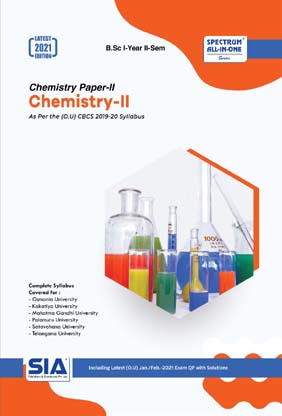

Note: Please check your Spam or Junk folder, in case you didn't receive the email with verification code.
SYLLABUS
UNIT-1
Inorganic chemistry S2–I–1P–block elements – ii Oxides : Type of oxides (a) Normal – acidic, basic, amphoteric and neutral (b) Mixed (c) Sub oxide (d) Peroxide (e) Superoxide. Structure of oxides of C, N, P, S and Cl – reactivity, thermal stability, hydrolysis. Oxy Acids : Structure and acidic nature of oxyacids of B, C, N, P, S, Cl and I. Redox properties of oxyacids of Nitrogen : HNO2 (reaction with FeSO4 , KMnO4 , K2 Cr2 O7 ), HNO3 (reaction with H2 S, Cu), HNO4 (reaction with KBr, Aniline), H2 N2 O2 (reaction with KMnO4 ). Redox properties of oxyacids of Phosphorus: H3 PO2 (reaction with HgCl2 ), H2 PO3 (reaction with AgNO3 , CuSO4 ). Redox properties of oxyacids of Sulphur : H2 SO3 (reaction with KMnO4 , K2 Cr2 O7 ), H2 SO4 (reaction with Zn, Fe, Cu), H2 S2 O3 (reaction with Cu, Au), H2 SO5 (reaction with KI, FeSO4 ), H2 S2 O8 (reaction with FeSO4 , KI). Redox properties of oxy acids of Chlorine. Interhalogens : Classification – general preparation – structure of AB, AB3 , AB5 and AB7 type and reactivity. Poly halides : Definition and structure of ICl2 – , ICl4 – and I3 – . Pseudohalogens :Comparison with halogens. S2 – I – 2: Chemistry of zero group elements Isolation of noble gases, Structure, bonding and reactivity of Xenon compounds – Oxides, Halides and Oxy–halides. Clatherate compounds and Anomalous behavior of He (II). S2 – I – 3: Chemistry of d – block elements Characteristics of d-block elements with special reference to electronic configuration, variable valence, ability to form complexes, magnetic properties & catalytic properties. Stability of various oxidation states and Standard Reduction Potentials. Comparative treatment of second and third transition series with their 3d analogues. Study of Ti, Cr and Cu triads. Titanium triad – electronic configuration and reactivity of +3 and +4 states – oxides and halides. Chromium triad – reactivity of +3 and +6 states. Copper triad – reactivity of +1, +2 and +3 states.
UNIT-2
Organic chemistry S2–O–1 : Halogen compounds Classification: alkyl (Primary, secondary, tertiary), aryl, aralkyl, allyl, vinyl, benzyl. Chemical reactivity - Reduction, Formation of RMgX, Nucleophilic substitution reactions - Classification into SN1 and SN2. Mechanism and energy profile diagrams of SN1 and SN2 Reactions. Stereochemistry of SN 2 (Walden Inversion) 2-bromobutane, SN 1 (Racemisation) 1-bromo-1 -phenylpropane. Structure and reactivity - Ease of hydrolysis - Comparison of alkyl, vinyl, allyl, aryl, and benzyl halides. S2–O–2 : Hydroxy compounds and ethers Alcohols : Preparation: 1°, 2° and 3° alcohols using Grignard reagent, Reduction of Carbonyl compounds, carboxylic acids and esters. Physical properties: H-bonding, Boiling point and Solubility. Reactions with Sodium, HX/ZnCl2 (Lucas reagent), esterification, oxidation with PCC, alk KMnO4 , acidic dichromates, conc. HNO3 and Oppenauer oxidation (Mechanism).
Phenols : Preparation : (i) From diazonium salts of anilines, (ii) From benzene sulphonic acids and (iii) Cumene hydroperoxide Properties: Acidic nature, formation of phenoxide and reaction with R-X, electrophilic substitution; halogenations, Riemer Tiemann reaction (Mechanism), Kolbe reaction (Mechanism), GattermannKoch reaction, Azo-coupling reaction, Schottan-Boumann reaction, Houben-Hoesch condensation. Ethers: Nomenclature, preparation by (a) Williamson’s synthesis (b) from alkenes by the action of conc . H2 SO4 . Physical properties - Absence of Hydrogen bonding, insoluble in water, low boiling point. Chemical properties - inert nature, action of conc. H2 SO4 and HI. S2–O–3 : Carbonyl compounds Preparation of aldehydes & ketones from acid chloride, 1,3-dithianes, nitriles and from carboxylic acids. Special methods of preparing aromatic aldehydes and ketones by (a) Oxidation of arenes (b) Hydrolysis of benzal halides. Physical properties - absence of Hydrogen bonding, Reactivity of the carbonyl groups in aldehydes and ketones. Chemical reactivity: Addition of (a) NaHSO3 (b) HCN (c) RMgX (d) NH3 (e) RNH2 (f) NH2 OH (g) PhNHNH2 (h) 2, 4-DNP (Schiff bases).Addition of H2 O to form hydrate, chloral hydrate (stable), addition of alcohols - hemi acetal and acetal formation. Cannizaro reaction. Oxidation reactions - KMnO4 oxidation and auto oxidation, reduction - Catalytic hydrogenation, mechanism of Clemmenson’s reduction, Wolf - kishner reduction, Meerwein Pondoff Verly reduction. Reduction with LAH, NaBH4 .
UNIT-3
Physical chemistry S2–P–1 : Electrochemistry Electrical transport - Conduction in Metals and in Electrolyte Solutions, Specific Conductance and Equivalent Conductance, Measurement of Equivalent Conductance, Variation of Specific and Equivalent Conductance with Dilution. Migration of Ions and Kholraush’s law, Arrhenius theory of Electrolyte Dissociation and its Limitations, weak and strong electrolytes, Ostwald’s dilution law - its uses and limitations. Debye-HuckelOnsagar’s equation for strong electrolytes (elementary treatment only). Transport number, definition and determination by Hittorf’s method for attackable electrodes. Applications of conductivity measurements : Determination of degree of dissociation, determination of Ka of acids, determination of solubility product of a sparingly soluble salt, conductometric titrations. Electrolytic and Galvanic cells - reversible and irreversible cells, conventional representation of electrochemical cells. Electro motive force (EMF) of a cell and its measurement. Computation of EMF. Types of reversible electrodes - the gas electrode, metal-metal ion, metal-insoluble salt and redox electrodes. Electrode reactions, Nernst equation, cell EMF and Single electrode potential, Standard Hydrogen electrode - Reference electrodes (calomel electrode) - standard electrode potential, sign conventions, electrochemical series and its significance. Applications of EMF measurements, Calculation of thermodynamic quantities of cell reactions (Gibbs free energy G, Helmholtz free energy and Equilibrium constant K). Determination of pH using hydrogen electrode, glass electrode and quinhydrone electrode. Solubility product of AgCl. Potentiometric titration.
UNIT-4
General chemistry S2–G–1 : theory of quantitative analysis Volumetric Analysis : Introduction, standard solutions, indicators, end point, titration curves, Types of Titrations : (i) Neutralization titration - principle, theory of acid base indicators, titration curves and selection of indicators - strong acid - strong base, strong acid - weak base, weak acid - strong base and weak acid - weak base. Theory of redox titrations - internal(KMnO4 ) and external indicators - use of diphenylamine and ferroin indicators. Theory of complexometric titrations - Use of EBT, Murexide and Fast sulphone black indicators. Role of pH in complexometric titrations. Precipitation titrations - theory of adsorption indicators. Gravimetric analysis - Introduction, nucleation, precipitation, growth of precipitate, filtration and washing, drying and incineration of precipitate, coprecipitation and post precipitation. Determination of Ni2+ S2–G–2 : Stereoisomerism Optical Activity: Definition, wave nature of light, plane polarised light, optical rotation and specific rotation, Chiral centers. Chiral molecules: definition and criteria - absence of plane, center and Sn axis of symmetry - asymetric and dissymmetric molecules. Examples of asymetric molecules (Glyceraldehyde, Lactic acid, Alanine) and disymmetric molecules (trans-1, 2-dichlorocyclopropane). Molecules with constitutionally symmetrical chiral carbons (Tartaric acid) Molecules with constitutionally unsymmetrical chiral carbons (2,3 dibromopentane) D, L configuration - examples. R, S - configuration: Cahn-Ingold- Prelog rules, examples for asymmetric and disymmetric molecules. S2–G–3 : Dilute solutions and colligative properties Dilute solutions, Colligative properties, Raoult’s law, relative lowering of vapour pressure, molecular weight determination. Osmosis - laws of osmotic pressure, its measurement, determination of molecular weight from osmotic pressure. Elevation of boiling point and depression of freezing point. Derivation of relation between molecular weight and elevation in boiling point and depression in freezing point.
 No Preview is available for this book
No Preview is available for this book

 Get 100 instant uPoints on the purchase of Rs.100 or above for each order.
Get 100 instant uPoints on the purchase of Rs.100 or above for each order.
CategoriesArts and Science

Format PDF

TypeeBook